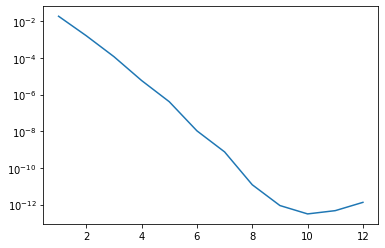This page was generated from unit-9.3-highorder/highorder.ipynb.
9.3 High Order Finite Elements¶
Finite elements implement the basis functions: myHOElement.hpp myHOElement.cpp
Finite element spaces implement the enumeration of degrees of freedom, and creation of elements: myHOFESpace.hpp myHOFESpace.cpp
[1]:
from ngsolve.fem import CompilePythonModule
from pathlib import Path
m = CompilePythonModule(Path('mymodule.cpp'), init_function_name='mymodule')
called mymodule
In file included from /usr/bin/../include/netgen/fem.hpp:75,
from /usr/bin/../include/netgen/comp.hpp:10,
from /root/src/ngsolve/docs/i-tutorials/unit-9.3-highorder/mymodule.cpp:1:
/usr/bin/../include/netgen/diffop.hpp: In function ‘std::shared_ptr<ngfem::DifferentialOperator> ngfem::CreateFunctionDiffOp(const DOP&, const F&, int)’:
/usr/bin/../include/netgen/diffop.hpp:1127:24: warning: ‘template<class DOP, class F> class ngfem::T_FunctionDiffOp’ is deprecated: guess it never got over the first experimental use [-Wdeprecated-declarations]
1127 | return make_shared<T_FunctionDiffOp<DOP, F>> (func, dim);
| ^~~~~~~~~~~~~~~~
/usr/bin/../include/netgen/diffop.hpp:1062:3: note: declared here
1062 | T_FunctionDiffOp : public DifferentialOperator
| ^~~~~~~~~~~~~~~~
[2]:
from netgen.occ import unit_square
from ngsolve import *
from ngsolve.webgui import Draw
mesh = Mesh(unit_square.GenerateMesh(maxh=0.2, quad_dominated=False))
We can now create an instance of our own finite element space:
[3]:
fes = m.MyHighOrderFESpace(mesh, order=4, dirichlet="left|bottom|top")
and use it within NGSolve such as the builtin finite element spaces:
[4]:
print ("ndof = ", fes.ndof)
ndof = 489
[5]:
gfu = GridFunction(fes)
gfu.Set(x*x*y*y)
Draw (gfu)
Draw (grad(gfu)[0], mesh);
and solve the standard problem:
[6]:
u,v = fes.TnT()
a = BilinearForm(grad(u)*grad(v)*dx).Assemble()
f = LinearForm(10*v*dx).Assemble()
gfu.vec.data = a.mat.Inverse(fes.FreeDofs())*f.vec
Draw (gfu, order=3);
[7]:
errlist = []
for p in range(1,13):
fes = m.MyHighOrderFESpace(mesh, order=p)
func = sin(pi*x)*sin(pi*y)
gfu = GridFunction(fes)
gfu.Set(func)
err = sqrt(Integrate( (func-gfu)**2, mesh, order=5+2*p))
errlist.append((p,err))
print (errlist)
[(1, 0.018470561568516793), (2, 0.001602867608186379), (3, 0.00011616801501656098), (4, 5.799927993927836e-06), (5, 4.0563658382219457e-07), (6, 1.0475203105369778e-08), (7, 7.452332085368543e-10), (8, 1.2039759522275085e-11), (9, 8.858089559311819e-13), (10, 3.0963984468444877e-13), (11, 4.670388275962591e-13), (12, 1.3230051795246677e-12)]
[8]:
import matplotlib.pyplot as plt
n,err = zip(*errlist)
plt.yscale('log')
plt.plot(n,err);

Exercises:
Extend MyHighOrderFESpace by high order quadrilateral elements.
http://www.numa.uni-linz.ac.at/Teaching/PhD/Finished/zaglmayr-diss.pdf, page 68 ff
[ ]: